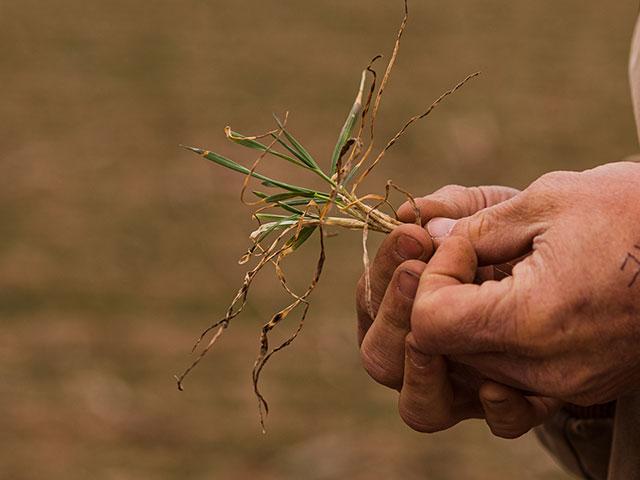Drought Puts Wheat Crop in Jeopardy
Across the Southern Plains, Winter Wheat Suffers Without Rain
JEFFERSON CITY, Mo. (DTN) -- These days, Kyle Krier isn't sure how many times to say "very" when he describes the persistent dryness that surrounds his central Kansas farm.
"It is very, very dry," he said this week of the conditions near Claflin, roughly two hours northwest of Wichita. He estimated that his farm has received about 1.3 inches of total precipitation in the past six months. "And there's no rain in sight."
Krier isn't alone. Across much of the Southern Plains, near- or above-normal rainfall hasn't fallen since last August. In some areas, the last appreciable rain took place in May 2022. As a result, the region finds itself in the grips of a drought that threatens to significantly affect the success of this year's winter wheat crop.
"We've had a very active weather pattern across the country the past four months, but this area just has not been able to see anything significant out of it," said DTN Ag Meteorologist John Baranick. "They are being skipped over again by a system here on Friday."
During the past three months, much of the region has had less than an inch of rain, Baranick said. For most areas, this is less than half of normal rainfall. For example, Dodge City, Kansas, has recorded 1 inch of rain since the beginning of 2023. Normally, 2.5 inches would have fallen. Similar deficits can be found from Pueblo, Colorado (0.73 inch actual versus 1.48 inches normal), to Amarillo, Texas (0.93 inch versus 2.51 inches), to Lubbock, Texas (0.75 inch versus 2.45 inches).
P[L1] D[0x0] M[300x250] OOP[F] ADUNIT[] T[]
As a result, drought conditions widely persist. According to the U.S. Drought Monitor, more than 65% of Kansas, 79% of Nebraska, 48% of Oklahoma and 46% of Texas are under severe to exceptional drought.
Winter wheat in the region has suffered. In some places, wheat that was seeded in the fall never even germinated due to lack of moisture. Where stands were established, the subsoil moisture has dwindled, placing the crop's future in doubt. Surviving stands also have had to contend with freeze damage and punishing winds.
The most recent report from the USDA National Agricultural Statistics Service estimated 52% of the Kansas winter wheat crop to be in poor or very poor condition, compared to only 32% during the same week last year. In other states, the wheat crop is similarly stressed this year and considered to be in poor or very poor condition: 48% in Texas, 44% in Nebraska and 32% in Oklahoma.
Gary Millershaski farms in west-central Kansas' Kearny County. He said he typically averages 18.8 inches of rain annually; he's had only 8.6 inches in the past year. He estimates that two-thirds of his wheat will be abandoned, but he can't plant a spring crop because there is no subsoil moisture.
"I'm not going to chase another crop in dry soil," he said, noting that crop adjusters are coming out next week. "Right now, it's all about getting by and spending the least amount possible."
Back in central Kansas, Krier said his wheat crop looks dismal, and the hay forage crops he grows aren't much better unless they have the benefit of irrigation.
"We will cut some wheat if it rains, but nothing above our crop insurance averages unless it rains in the next week," he said. If the drought continues through April, he expects very little wheat to survive.
Baranick said the active weather pattern will continue. Another large system will move across the country early next week -- but it's expected to bypass the Southern Plains again.
"There is some hope for Easter weekend at getting some rain there, though that's a long shot right now," he said.
Jason Jenkins can be reached at jason.jenkins@dtn.com
Follow him on Twitter @JasonJenkinsDTN
(c) Copyright 2023 DTN, LLC. All rights reserved.






